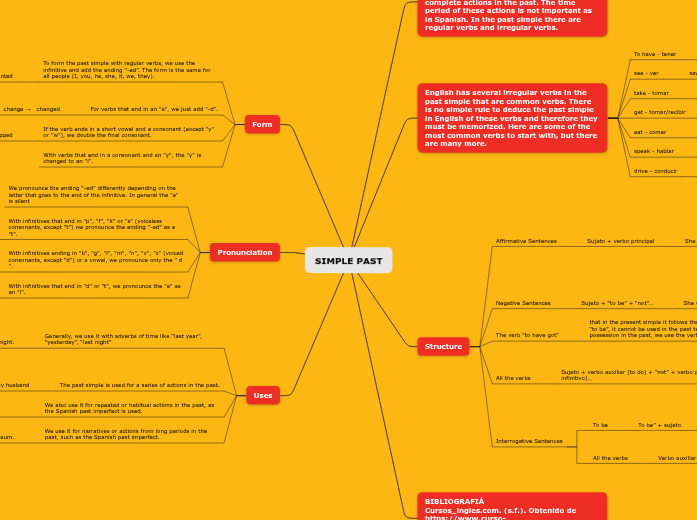
To have - tener
had
see - ver
saw
take - tomar
took
get - tomar/recibir
got
eat - comer
ate
speak - hablar
spoke
drive - conducir
drove
Affirmative Sentences
Sujeto + verbo principal
She was a doctor.
The keys were in the drawer.
I wanted to dance.
They learned English.
We believed him.
I bought a blue car
Negative Sentences
Sujeto + “to be” + “not”…
She wasn’t a doctor.
The keys weren’t in the drawer.
The verb "to have got"
that in the present simple it follows the same rules as the verb “to be”, it cannot be used in the past tense. To indicate possession in the past, we use the verb "to have".
All the verbs
Sujeto + verbo auxiliar (to do) + “not” + verbo principal (en infinitivo)…
I didn’t want to dance.
They didn’t learn English.
We didn’t believe him.
I didn’t buy a blue car.
Interrogative Sentences
To be
To be” + sujeto
Was she a doctor
All the verbs
Verbo auxiliar (to do) + sujeto + verbo principal (en infinitivo)
Did you want to dance
Did they learn English
Did you believe him
To form the past simple with regular verbs, we use the infinitive and add the ending “-ed”. The form is the same for all people (I, you, he, she, it, we, they).
want → wanted
learn → learned
stay → stayed
For verbs that end in an "e", we just add "-d".
change → changed
believe → believed
If the verb ends in a short vowel and a consonant (except "y" or "w"), we double the final consonant.
stop → stopped
commit → committed
With verbs that end in a consonant and an "y", the "y" is changed to an "i".
We pronounce the ending “-ed” differently depending on the letter that goes to the end of the infinitive. In general the "e" is silent
With infinitives that end in "p", "f", "k" or "s" (voiceless consonants, except "t") we pronounce the ending "-ed" as a "t".
looked[lukt]
kissed[kisst]
With infinitives ending in "b", "g", "l", "m", "n", "v", "z" (voiced consonants, except "d") or a vowel, we pronounce only the " d ".
yelled[jeld]
cleaned[klind]
With infinitives that end in "d" or "t", we pronounce the "e" as an "i".
ended[endid]
waited[weitid]
Generally, we use it with adverbs of time like “last year”, “yesterday”, “last night”
om stayed at home last night.
Kate worked last Saturday.
I didn’t go to the party yesterday.
Did they walk to school this morning?
The past simple is used for a series of actions in the past.
I received the good news and immediately called my husband
We also use it for repeated or habitual actions in the past, as the Spanish past imperfect is used.
We always traveled to Cancun for vacation when we were young
We use it for narratives or actions from long periods in the past, such as the Spanish past imperfect.
I worked for many years in a museum.